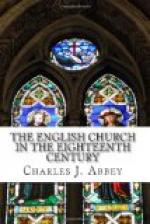Dean of Canterbury. In later years this intimacy
was somewhat interrupted by great divergence of views
on theological and ecclesiastical subjects; but a
strong feeling of mutual respect remained, and, in
his last illness, Tillotson was nursed by his friend
with the most affectionate love, and died in his arms.
In 1680 Nelson went to France with Halley, his old
schoolfellow and fellow member of the Royal Society,
and during their journey watched with his friend the
celebrated comet which bears Halley’s name.
While in Paris he received the offer of a place in
Charles II.’s Court, but took the advice of
Tillotson, who said he should be glad ’if England
were so happy as that the Court might be a fit place
for him to live in.’[1] He therefore declined
the offer, and travelled on to Rome, where he made
the acquaintance of Lady Theophila Lucy and married
her the next year. It was no light trouble to
him that on their return to London she avowed herself
a Romanist. Cardinal Howard at Rome, and Bossuet
at Paris, had gained her over to their faith, and
with the ardour of a proselyte she even entered, on
the Roman side, into the great controversy of the day.
Robert Nelson himself was entirely unaffected by the
current which just at this time seemed to have set
in in favour of Rome. He maintained, indeed,
a cordial friendship with Bossuet, but was not shaken
by his arguments, and in 1688 published, as his first
work, a treatise against transubstantiation.
Though controversy was little to his taste, these
were times when men of earnest conviction could scarcely
avoid engaging in it.[2] Nelson valued the name of
Protestant next only to that of Catholic, and was
therefore drawn almost necessarily into taking some
part in the last great dispute with Rome.[3] But polemics
would be deprived of their gall of bitterness if combatants
joined in the strife with as much charity and generosity
of feeling as he did.[4]
From the first Nelson felt himself unable to transfer
his allegiance to the new Government. The only
question in his mind was whether he could consistently
join in Church services in which public prayers were
offered in behalf of a prince whose claims he utterly
repudiated. He consulted Archbishop Tillotson
on the point; and his old friend answered with all
candour that if his opinions were so decided that he
was verily persuaded such a prayer was sinful, there
could be no doubt as to what he should do. Upon
this he at once joined the Nonjuring communion.
He remained in it for nearly twenty years, on terms
of cordial intimacy with most of its chief leaders.
When, however, in 1709, Lloyd, the deprived Bishop
of Norwich, died, Nelson wrote to Ken, now the sole
survivor of the Nonjuring bishops, and asked whether
he claimed his allegiance to him as his rightful spiritual
father. As regards the State prayers, time had
modified his views. He retained his Jacobite
principles, but considered that non-concurrence in
certain petitions in the service did not necessitate
a prolonged breach of Church unity. Ken, who
had welcomed the accession of his friend Hooper to
the see of Bath and Wells, and who no longer subscribed
himself under his old episcopal title, gave a glad
consent, for he also longed to see the schism healed.
Nelson accordingly, with Dodwell and other moderate
Nonjurors, rejoined the communion of the National
Church.




